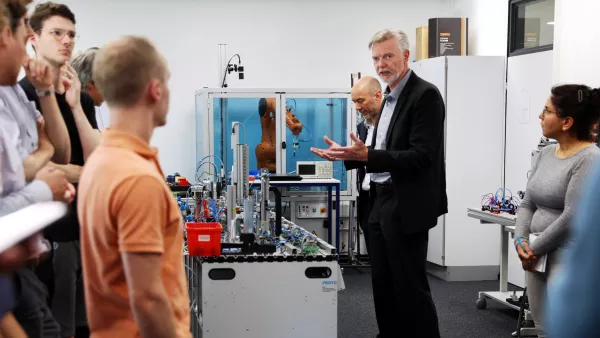
On July 22, the Institute for Digital Change (IDW) hosted a presentation of the results of the AI-based digital twin (KIDZ) research project. The event offered an expert audience and participating cooperation partners the opportunity to gain insights from the now completed research project. The aim of the research was to develop an AI-supported, self-learning digital twin that continuously monitors and realistically maps production processes. The basis is a model that not only processes data, but also recognizes its meaning and correlations. This allows complex processes to be better explained, simulated and optimized - enabling more effective and transparent production. Methods of eXplainable AI (XAI), i.e. the traceability of AI, provide additional transparency.
Research results and specialist presentations
The event was kicked off by Professor Dr. Wolfram Höpken, spokesperson for the project and head of the IDW. He emphasized the importance of a holistic approach in the development of digital twins: "Our goal is not just to collect data, but to understand their interrelationships and create actionable models from them." He pointed out that the following specialist presentations will explore various aspects of this overarching research objective in greater depth and thus paint a comprehensive picture of the project work. The results and findings are also being continuously processed in scientific publications, some of which have already been published, while others are still in progress.
The specialist presentations by the scientific staff from the KIDZ project highlighted various in-depth aspects. Timo Schuchter presented his approach to the automated planning of production facilities. The aim was to use a knowledge-based ontology, i.e. a structured system for mapping knowledge about components and their relationships, to investigate how digital twins can independently design, simulate and virtually commission suitable plant structures. This approach simplifies and accelerates complex planning, as the systems make decisions independently on the basis of the stored knowledge.
In the next presentation, Nishanth Nandakumar explained his research into the automated generation of synthetic image data in order to simplify the often time-consuming and manual process of data creation. This allows AI systems to be trained faster and more efficiently for image analysis tasks. Finally, Alexander Lohr presented an AI-based system that uses large language models to explain knowledge gained about the production process in an understandable way. The aim is to provide specialists with transparent and comprehensible support when using the digital twin.
Practical demonstration and future prospects
The highlight of the event was a joint live demonstration in which the three sub-projects were presented in successful and, in contrast, unsuccessful scenarios. This gave the audience a tangible impression of how the developed AI solutions support real-life applications and which sources of error can be reduced. A final get-together in a relaxed atmosphere with snacks and drinks gave interested parties and researchers the opportunity to delve even deeper into the topics. On this evening, special thanks went to the Carl Zeiss Foundation, which funded the research project for more than three years, as well as the project partners IKS Intec, IILS, lfm syntron, FORCAM and the Institute of Aircraft Design at the University of Stuttgart for their project support and assistance. The IDW is now working on securing follow-up funding to continue the research work.
Downloads
- Abschlusspräsentation des KIDZ-Forschungsprojekt